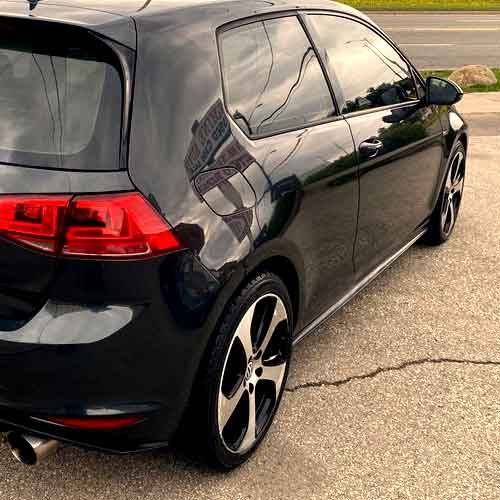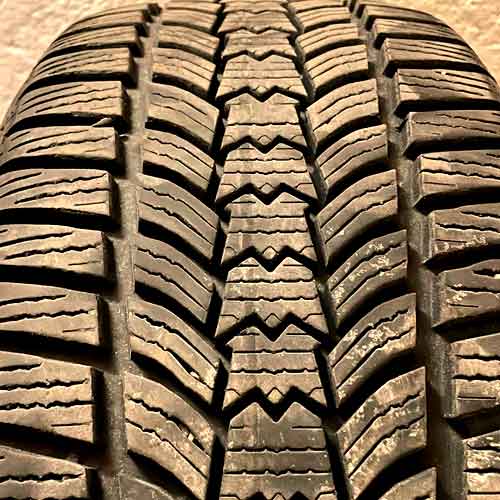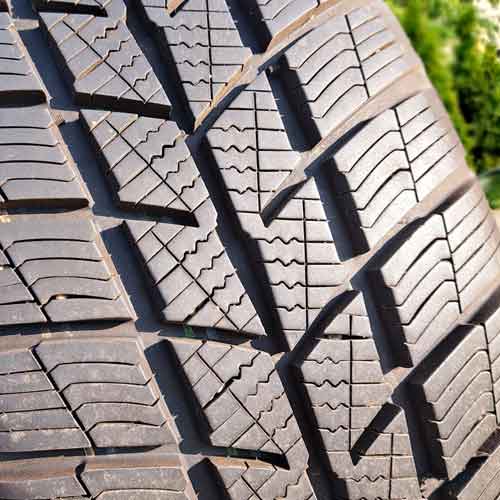Both Sava Eskimo HP2 and Barum Polaris 5 are heavyweights in the winter tire division, each bringing a unique set of skills to tackle icy and snowy conditions. In this frosty face-off, let’s find out who packs the hardest punch!

Table of Contents
Key Takeaway:
So overall, it all comes down to this.
Sava Eskimo HP2 excels in:
- Ice Performance: Complex tread design with various angled slits and aggressive siping for shorter braking distances and better maneuverability on ice.
- Tread Life: Lighter structure resulting in extended tread wear.
- Dry Traction: Superior directional grip and handling due to streamlined lugs and closely-spaced lateral voids.
- Wet Gripping: Enhanced siping design with multi-angled orientations.
- Fuel Efficiency: Streamlined, longitudinally aligned ribs reducing rolling resistance.
- Ride Comfort: Less-voided tread design for reduced road noise and improved response times.
Barum Polaris 5 (review) stands out for:
- Snow Performance: Bold directional tread pattern adept at capturing loose snow particles, and abundant snow vices and interlocking grooves for better snow traction.
- Resistance to Hydroplaning: Demonstrates high hydroplaning resistance with interconnected tread voids and higher float speeds in aquaplaning tests.
- Ride Comfort: Softer rubber compound for superior vibration dampening.
Moreover, both tires have similar wet performance values, (I mean, both have equal scores here), as the Sava Eskimo HP2 excels in wet grip performance, Barum Polaris 5 is superior in hydroplaning or aquaplaning resistance.
Ice Performance
The Sava Eskimo HP2 stands out in icy conditions, coming with a distinctive and complex tread design comprised of variously-sized angled slits and snow vices, thus setting a new industry benchmark.

The tire’s performance is further bolstered by its aggressive siping pattern, which shortens braking distances and enhances vehicle maneuverability by supplying additional biting edges.
This design feature consequently elevates the grip on icy surfaces.
However, the Barum Polaris 5 encounters difficulties on icy surfaces owing to its larger tread voids and fewer notches.
Its main tread area struggles to secure a strong grip on compacted ice, and its lack of multi-directional sipes diminishes its overall performance on ice.
But the main reason the Barum lacks here, is it’s greater construction weight relatively.
With greater weight, the tire basically gains more momentum, and so despite having a mix of both linear and wave-like siping, it can’t offer similar results.
Moreover, the Sava has the edge here of it’s central most W shaped blocks, which create more bite.
So it’s that combined effect which puts the Eskimo HP2 over its counterpart.
Tread Life
Tread longevity is heavily influenced by the tire’s weight and tread design.

That’s why the Sava Eskimo HP2, known for its impressive tread life, where it benefits from its lighter structure, is not only helping its ice traction only.
This feature minimizes the force exerted on the rubber during road contact, thereby extending tread wear.
In contrast, the Barum, with its heavier weight and larger voids, has its increased weight distributed over a smaller rubber surface area.
This results in each lug bearing higher pressure and experiencing greater friction, accelerating tread wear.
Consequently, the Polaris 5 tends to wear out faster in comparison.
Dry Traction
In dry conditions, the Sava Eskimo HP2 excels in both directional grip and handling, the two vital facets of dry performance.
The tire’s directional grip primarily hinges on the central tread area, where the Sava showcases more streamlined lugs for consistent road contact, thereby improving both braking and acceleration.
If you check out their tread pattern again, you’d note that the Barum has longitudinal voids in the middle most, whereas Save has unique W shaped lugs, which not only offers greater rubber/road meet-up but also add to the tire’s bite, enhancing its overall longitudinal grip.
Moreover, the Sava’s handling, largely dependent on the tire’s shoulder design, is enhanced by closely-spaced lateral voids that increase rubber-to-road contact during cornering, whereas its competitor, with wider grooves, and more weight, induces lug bending.
This causes the tire to have slower steering response in comparison.
So overall, in the realm of dry performance the Sava Eskimo HP2 is taking the lead.
Snow Performance
Both tires exhibit excellent performance in snowy conditions, each equipped to navigate various types of snow.
However, the Polaris 5 has an edge due to its bold directional tread pattern, enriched by lugs with spacious structures adept at capturing loose, fluffy snow particles.
The tire’s abundant snow vices and interlocking grooves also help trap snow, facilitating better ground contact as snow tends to stick better to itself than to rubber.
In contrast, the Sava Eskimo HP2’s more compact design lacks an interlocking groove structure, inhibiting its ability to accumulate as much snow as its competitor and thereby slightly compromising its snow performance.
Therefore, the Barum Polaris 5 maintains an advantage in snow handling.
Wet Traction
Wet traction is dependent on the tire’s tread design and rubber composition, affecting two critical aspects of overall wet performance: wet grip and hydroplaning resistance.
Let’s start with grip.
Wet Gripping
Wet grip, similar to dry grip, relies on the amount of rubber in contact with the road. However, the presence of water creates a barrier, preventing full tread-to-surface contact and necessitating water displacement.
This task is performed by grooves and sipes.
While grooves expel the majority of water, providing hydroplaning resistance (discussed later), sipes handle the remaining water particles at a micro level.
With that understanding, it makes sense why the Sava Eskimo HP2 demonstrates superior performance in this respect due to its effective siping.
Its dual siping design features better multi-angled orientations, enhancing grip from all sides, whereas in contrast, the Barum Polaris 5, although less effective in gripping, performs better in hydroplaning resistance.
Resistance to Hydroplaning
Hydroplaning resistance, is a phenomenon which happens when water comes in between the tire and the road. And this happens because water has to go somewhere (as it’s not compressible). So if it’s not going out, it would cause the complete loss of traction.
This is why tires have grooves, which channel out the water, preventing hydro or aquaplaning.
Now having said that, the Polaris 5 exhibits remarkable hydroplaning resistance, attaining higher float speeds in both curved and straight aquaplaning tests.
Float speed measures the tire’s speed over standing water, and the Barum excels due to its wider and interconnected tread voids.
Moreover, it also creates a better negative pressure against water, throwing it out in all direction with greater efficacy.
So overall, the in both curved and straight hydroplaning tests, the Polaris 5 is superior.
Fuel Efficiency
A tire’s fuel efficiency is intrinsically linked to its traction and weight, which contribute to the tire’s rolling resistance.
More specifically, a heavier tire with larger tread voids induces more lug flexing or deformation during cornering, braking, or acceleration.
This flexing process requires more energy, a characteristic notably present in the Barum Polaris 5.
With flexing of the lugs, the energy is wasted in to heat, for the most part, and that not only affects tread life, but also greater enhance the rolling resistance value for the tire.
And this explanation is in sync with our testing with these tires.
Conversely, the Sava Eskimo HP2, featuring streamlined and longitudinally aligned ribs, significantly reduces rolling resistance, providing superior fuel efficiency. So needless to say, you get a greater distance traveled per gallon of fuel, with this tire.
Ride Comfort
Ride comfort encompasses several elements, including road noise, vibration dampening, tread pattern, and sidewall design.
The Sava Eskimo HP2 has a minor edge in terms of road noise due to its less-voided tread design, reducing the amount of air that can circulate, thereby minimizing noise generation.
Moreover, its lighter structure enhances response times, ensuring a smoother, more refined ride.
However, the Barum Polaris 5, although lagging in noise reduction and smoothness, excels in vibration dampening due to its softer rubber compound.
This feature enables it to absorb road irregularities, providing a perceivable improvement in ride comfort compared to the Sava’s tire.
Basically, the Eskimo has a more stiffer internal construction ,where its cap ply is the main culprit, which decreases its overall bump absorption efficacy.
Summing Up
Now, overall, the choice between these two tires depends on the specific driving conditions and the individual preferences of the driver.
The Eskimo HP2 consistently outperforms in icy conditions, tread life, dry traction, and fuel efficiency, primarily due to its intricate tread design, lighter structure, and optimized siping.
Moreover, the tire’s unique W-shaped blocks and aggressive siping patterns ensure superior grip on icy surfaces and longer tread longevity.
Moreover, in dry and wet conditions, the Sava showcases superior directional grip and wet grip, respectively, while the Polaris 5 stands out in terms of hydroplaning resistance and snow performance.
The Barum’s bold tread design excels in capturing and navigating through snow, and its wider tread voids efficiently dispel water, granting it an advantage in hydroplaning tests.
In terms of fuel efficiency, the Sava’s design leads to reduced rolling resistance, ensuring better mileage. However, when it comes to ride comfort, the Polaris 5’s softer rubber compound offers better vibration dampening, though its not quieter in comparison.